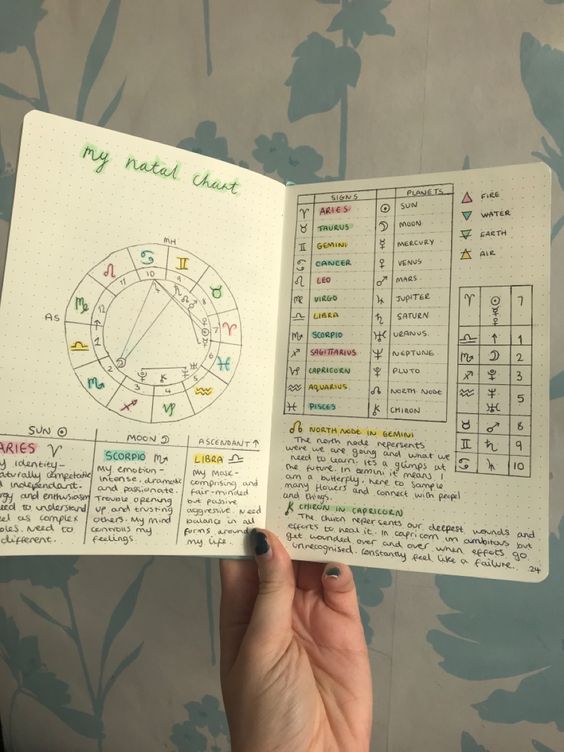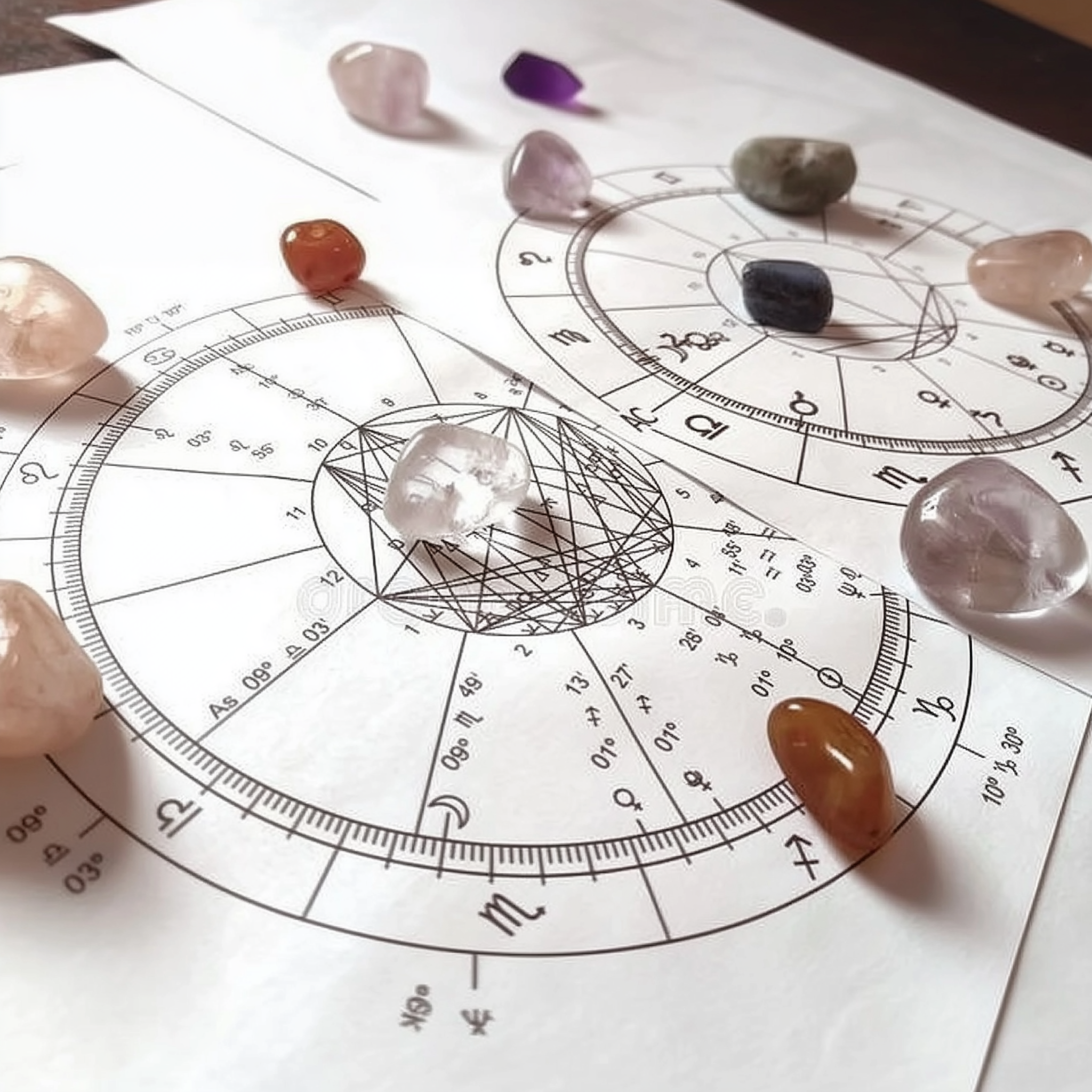 In astrology, aspects are the angles formed between planets in a natal chart during a specific time, representing how these planetary energies interact. Each aspect connects one body to another, and through those connections they reflect our experiences here on Earth. The word ‘aspect’ extends beyond astrology, sneaking its way into our everyday language? We speak of “aspects of life,” “aspects of personality,” and “aspects of a problem,” as if subconsciously recognizing that everything is connected, everything is in relationship to everything else—just as the planets are, just as we are. The angles we view things from, the relationships we form, are constantly shifting, just as the planets do in their eternal dance. Every interaction, every thought, every emotion is an aspect of something greater, something that, while perhaps beyond our full comprehension, is undeniably beautiful in its complexity.
In astrology, aspects are the angles formed between planets in a natal chart during a specific time, representing how these planetary energies interact. Each aspect connects one body to another, and through those connections they reflect our experiences here on Earth. The word ‘aspect’ extends beyond astrology, sneaking its way into our everyday language? We speak of “aspects of life,” “aspects of personality,” and “aspects of a problem,” as if subconsciously recognizing that everything is connected, everything is in relationship to everything else—just as the planets are, just as we are. The angles we view things from, the relationships we form, are constantly shifting, just as the planets do in their eternal dance. Every interaction, every thought, every emotion is an aspect of something greater, something that, while perhaps beyond our full comprehension, is undeniably beautiful in its complexity.
Here are the major aspects:
Conjunction (0°)
Description: Occurs when two planets are very close together, usually within a few degrees. Their energies blend and amplify each other.
Effect: Can be powerful and intense, but whether it’s positive or challenging depends on the planets involved.
Sextile (60°)
Description: Formed when planets are 60 degrees apart, usually two signs away from each other.
Effect: Represents opportunities, harmony, and ease. The planets involved cooperate well, but action may be needed to realize the potential.
Square (90°)
Description: Occurs when planets are 90 degrees apart, typically three signs away.
Effect: Represents tension, challenges, and obstacles. The energies of the planets clash, leading to potential conflict but also growth through struggle.
Trine (120°)
Description: Formed when planets are 120 degrees apart, usually four signs away.
Effect: Indicates harmony, flow, and ease. The planets work together effortlessly, often leading to positive outcomes without much effort.
Opposition (180°)
Description: Happens when planets are directly opposite each other in the zodiac.
Effect: Represents polarity, tension, and balance. The energies are in opposition, creating a push-pull dynamic that requires integration and compromise.
Quincunx (150°)
Description: Occurs when planets are 150 degrees apart, usually five signs away.
Effect: Represents incongruence and adjustment. The energies of the planets involved don’t easily understand each other, leading to discomfort that requires adaptation.
The Dinner Party
These aspects help astrologers interpret the dynamics within a chart, revealing how different planetary influences interact and affect a person’s life. Imagine you’re at a dinner party with a group of lively guests. Everyone is seated around an elegant, elliptical table. Depending on where you’re sitting, your interactions with others will vary.
– If you’re sitting right next to someone, you can lean in and whisper easily, sharing thoughts and ideas closely—this is like a conversation where you’re on the same page, deeply connected.
– If you’re seated across from someone, you can still see and talk to them, but there’s more distance. It might lead to a bit of a debate, as your perspectives differ, but there’s also a chance for a balanced exchange if you both listen.
– If you’re at a right angle to someone, you might find that you’re speaking over the person next to you, creating some tension in the conversation. It’s a little more challenging to communicate clearly, but with effort, you can work it out.
– If you’re seated at a comfortable angle, neither too close nor too far, conversation flows easily, with both parties finding it natural to share and agree.
– And if you’re at a slight angle, you might find opportunities to jump into a lively discussion, adding your thoughts in a way that feels supportive and encouraging.
In essence, the way you’re seated at the table—your angle to others—affects the nature of your interactions, just as aspects do in astrology. Just as at a dinner party, while you’re technically in the same room with everyone, you naturally gravitate toward those seated closest to you or directly across. You might exchange pleasantries with the person beside you, sharing secrets or jokes because the proximity makes it easy.
Picture the Moon and Mercury seated side by side at the dinner table, forming a close, intimate conjunction. The Moon, embodying emotion, intuition, and the subconscious, is the warm, nurturing guest who feels deeply and speaks of feelings and memories. She’s the one who listens attentively, offering a comforting presence that makes everyone feel at ease. Mercury, ever the communicator, is all about words, ideas, and logic. He’s the one who keeps the conversation flowing, asking questions, making connections, and sharing insights with his quick wit and sharp mind. When these two are in conjunction, it’s as if they’ve decided to team up for the evening, blending their energies into a seamless conversation. The Moon infuses Mercury’s words with emotion, giving them depth and resonance. Mercury, in turn, helps the Moon articulate her feelings with clarity and precision, translating her subtle emotions into something everyone at the table can understand.
Their dialogue is a perfect blend of head and heart—Mercury’s logical analysis softened by the Moon’s empathy, and the Moon’s emotional insights sharpened by Mercury’s clear expression. Together, they create a space where thoughts and feelings flow effortlessly, where what is said resonates deeply because it carries the weight of both intellect and emotion. This conjunction at the dinner table is a gentle, harmonious exchange, where ideas are shared not just with the mind but with the soul. It’s a conversation that leaves everyone feeling understood and connected.
Alternatively, the person directly across from you might catch your eye, and you engage in a more intense or meaningful conversation, possibly because of the directness of your positions. Imagine the Sun and Saturn seated directly across from each other at the dinner table, their energies in a tense but powerful opposition. The Sun, radiant and full of life, is the guest who lights up the room with charisma, confidence, and warmth. He’s the life of the party, effortlessly drawing everyone into his orbit. Saturn, on the other hand, is the stern, disciplined elder at the table. He’s the one who values structure, responsibility, and hard-earned wisdom. With a serious demeanor, Saturn might challenge the Sun’s self assured nature, reminding him of the importance of restraint, duty, and the long-term consequences of actions.
As they sit facing each other, the tension is obvious. The Sun shines brightly, eager to express himself, while Saturn, with his cautious and sometimes critical gaze, urges restraint and practicality. The Sun might feel frustrated, sensing that Saturn’s presence casts a shadow over his brightness, tempering his enthusiasm with the weight of reality. Saturn, meanwhile, might find the Sun’s boundless energy overwhelming, as if it challenges his need for order and control. This opposition at the dinner table is like a conversation where each is pulling in opposite directions—Sun trying to inspire and uplift, while Saturn anchors the discussion with realism and perhaps a touch of severity. The clash between the Sun’s desire for recognition and Saturn’s insistence on responsibility can create a dynamic where neither fully gets their way, but where both perspectives are essential.
Yet, despite the tension, this opposition can lead to a deep and meaningful exchange. The Sun, if willing to listen, can gain valuable insights from Saturn’s wisdom, learning the importance of patience and discipline. Saturn, if open to the Sun’s light, can be reminded of the joy and vitality that come from living life more fully. In the end, their opposition creates a powerful balance—where the Sun’s exuberance is tempered by Saturn’s realism, and Saturn’s seriousness is warmed by the Sun’s light. Their dialogue at the dinner table may be challenging, but it’s one that could ultimately lead to growth, respect, and a deeper understanding of the interplay between ambition and responsibility.
However, even though everyone at the table is present and part of the evening’s dynamics, the strongest interactions occur with those who are positioned in a way that naturally draws your attention. Similarly, in astrology, while every planet is in some kind of relationship with every other, the most impactful and noticeable interactions are those where the planets are in a particular angular relationship—those close or directly across interactions at the dinner party, if you will. These are the aspects that shape the main conversations of your life.
The square aspect is like sitting at a dinner party where you’re positioned at a right angle to someone. You’re close enough to be involved, but not directly facing each other, which can create a bit of an awkward, strained interaction. Imagine trying to converse with someone who’s just out of your direct line of sight. You have to turn awkwardly in your seat, and there’s a sense of strain as you try to keep the conversation going. You might feel like you’re talking past one another or that you’re not quite on the same wavelength. The conversation can become frustrating, like you’re not quite hearing each other clearly, and it takes more effort to stay engaged.
This blocking energy can be challenging, as it feels like there’s something in the way, a barrier that needs to be overcome. But it’s also in these challenging conversations that growth happens. The square pushes you out of your comfort zone, forcing you to find new ways to communicate or to address issues that might otherwise be ignored. So, while it can be frustrating, it also holds the potential for significant personal development—if you’re willing to work through the discomfort.
Imagine Mercury and Uranus at the dinner table, locked in a square aspect, creating an electrifying tension between them. Mercury, the quick-thinking, talkative guest, is all about logic, communication, and keeping things orderly. He’s got his notes ready, a plan for the evening’s discussion, and expects everyone to stick to the agenda. Uranus, on the other hand, is the wild card—unpredictable, rebellious, and bursting with innovative ideas that no one saw coming. He’s the guest who arrives with a completely different perspective, ready to shake things up, turning the conversation in directions Mercury never anticipated.
As they square off, Mercury is trying to keep the conversation on track, but Uranus keeps interrupting with sudden, off-the-wall insights that throw Mercury off balance. Mercury might start to feel frustrated, as if he’s losing control of the discussion, while Uranus thrives on the disruption, loving every moment of the intellectual chaos. The tension may lead to moments of frustration, it can also spark brilliant ideas and breakthroughs if they manage to find some common ground amidst the friction. In the end, the square between Mercury and Uranus at the dinner table might not result in a peaceful conversation, but it’s bound to be memorable, full of unexpected twists and turns, and potentially even enlightening, as long as both parties are willing to embrace the chaos.
Good and Bad Aspects
The evolution of astrological thought has moved from the rigid labels of ‘good’ and ‘bad’ aspects to a more nuanced understanding of planetary interactions. In the old days, astrologers were quick to slap a “good” or “bad” label on the aspects, as if life operated with the simplicity of a black-and-white moral code. But this view is not only simplistic but also woefully outdated. Today, we recognize that these so-called ‘hard’ and ‘soft’ aspects are more like different experiences, rather than strict judgments of good or bad. The ‘hard’ aspects—like the opposition and square, are challenging, but not in a malevolent sense. They demand effort, confrontation, and resolution, but they also offer the greatest opportunities for growth and transformation.
On the other side, the ‘soft’ aspects—trines and sextiles, facilitate flow, ease, and harmony, making things feel natural and effortless. But while they’re certainly pleasant, they don’t always push us to evolve. They can be the comfort zones of the astrological chart, where everything feels good, but where there’s less impetus for change.
And then there’s the conjunction, where two planets meet in the same place, shoulder to shoulder. This isn’t about division at all, but unity. A conjunction is like two guests arriving at the dinner party together, perhaps even wearing the same outfit. Their energies blend so closely that it’s hard to tell where one ends and the other begins. This can be incredibly potent, for better or worse, depending on the nature of the planets involved. It’s like a powerful partnership—sometimes it’s a dream team, and other times it’s two strong personalities vying for control in the same space.
When you look at a chart, certain aspects leap out at you, like the natural relationships between planets in different signs. Planets in cardinal signs—the initiatory signs of Aries, Cancer, Libra, and Capricorn—tend to square or oppose each other, creating that dynamic tension we spoke of earlier. Likewise, planets in air signs—Gemini, Libra, and Aquarius—often trine each other, flowing effortlessly in harmony, like a breeze catching your sail. But then, just when you think you’ve got it all figured out, along comes the disassociate aspect to remind you that life loves a twist. These aspects are the exceptions to the rule, where two planets form a familiar angle—like a trine, square, or opposition—but the signs they’re in don’t normally correspond to that aspect.
Disassociate aspects are like those moments when something doesn’t quite fit the mold but still holds significance. They occur when a planet at the very end of one sign forms an aspect with a planet at the very beginning of another. These planets are technically in aspect by degree, but they belong to signs that wouldn’t normally create such a relationship. In practical terms, disassociate squares, where you might expect a harsh clash of energies, tend to be a bit softer, less combative. The tension is still there, but it’s as if the planets aren’t fully committed to their usual roles in the square dance, leading to a bit more flexibility and room for negotiation. It’s like having a heated discussion with someone who, for some reason, isn’t as entrenched in their position—there’s still friction, but also more room for resolution.
Disassociate trines, which are typically smooth and harmonious, gain a bit of edge and dynamism. The ease is still present, but there’s a touch of unpredictability, a spark that adds excitement and movement to what might otherwise be a very comfortable and perhaps too easy flow. The subtlety here lies in recognizing that while the planets are connecting in a familiar pattern, they’re doing so from an unfamiliar vantage point, blending the expected with the unexpected.











